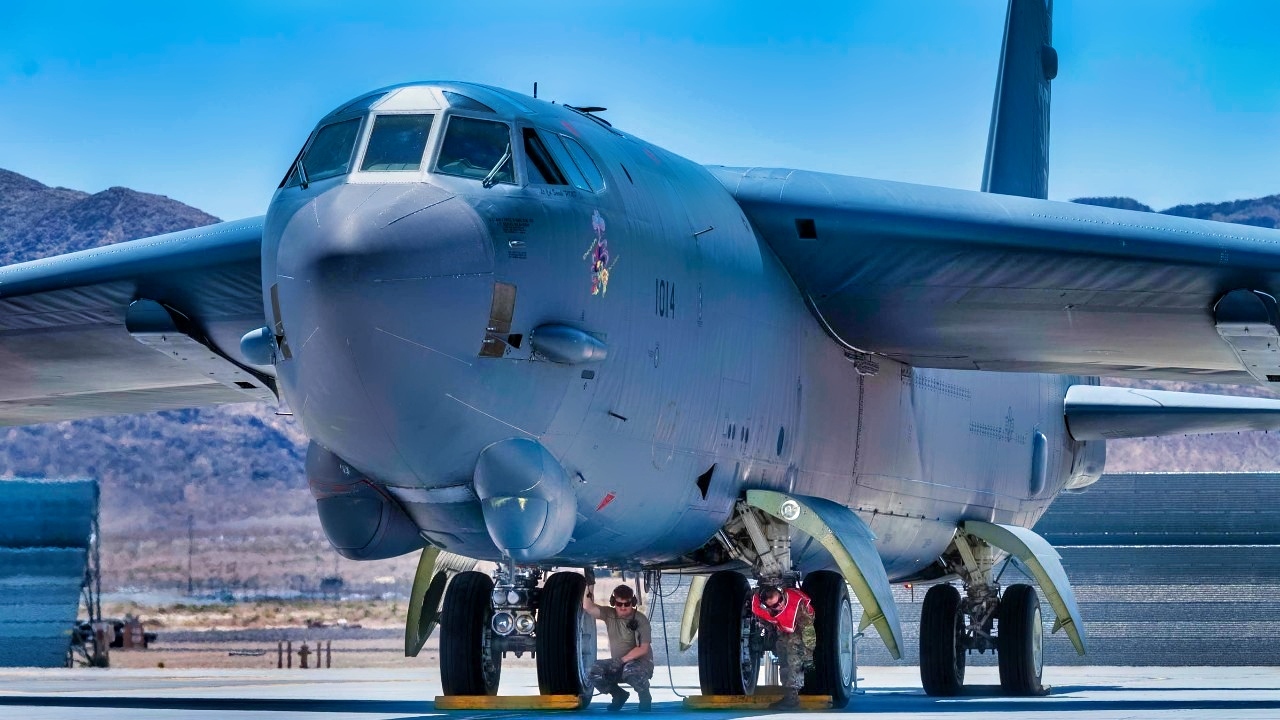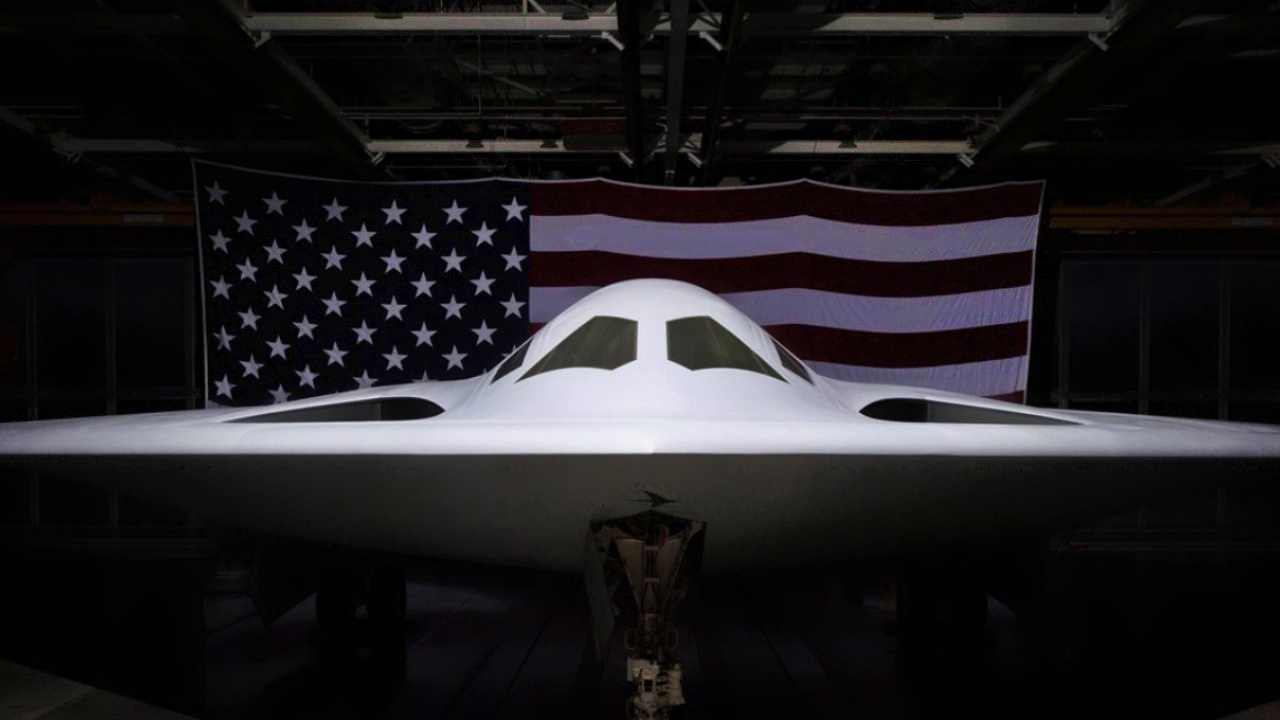Key Points and Summary: B-21 or B-52J? – Delays and cost growth in the B-52J upgrade—new F130 engines, AESA radar, and LRSO integration—have slipped initial operational capability to 2033, raising doubts about relying on a 1950s airframe as America’s long-range strike bridge.
-The Air Force plans to keep 76 B-52s into the 2050s, but each slip intensifies pressure to expand B-21 Raider buys beyond the 100 aircraft now planned.
-Leaders from STRATCOM and Global Strike argue for 145 or more; outside analysts urge 200.
-With production pacing at roughly 7–8 Raiders per year, the Pentagon must choose: gamble on refurbishing B-52s, or fund a substantially larger B-21 fleet.
The Pentagon Must Decide: Gamble on the B-52 Or Fund More B-21 Raider Bombers
As the United States Air Force invests heavily in growing its fleet of fifth-generation, fifth-generation-plus, and sixth-generation aircraft, it is also betting big on the B-52 Stratofortress – a bomber first fielded in the 1950s. An upgraded version of the aircraft – the B-52J – is now slated to fly into the 2050s alongside the B-21 Raider sixth-generation stealth bomber.
Under the B-52J upgrade program, the fleet will receive new Rolls-Royce F130 engines, a modern AESA radar, and nuclear capability through the integration of the Long-Range Standoff (LRSO) cruise missile – turning a Cold War relic into a “new” bomber.
The program is designed to extend the service life of America’s most durable bomber and provide a standoff strike platform that complements the stealthier Raider. But modernization has proven difficult so far. From inlet redesigns and radar integration delays to rising costs, the program has already pushed initial operational capability back to 2033, prompting questions about whether the Air Force can rely on the B-52 as a bridge until the U.S. can field a much larger, next-generation bomber fleet. That uncertainty has prompted many analysts to suggest that plans to field over 100 B-21 Raiders may be too conservative.
Turning the B-52 Into A Modern Bomber
The B-52 Stratofortress has been flying for seven decades, and while most Cold War designs have long since been retired, the Air Force has repeatedly chosen to keep the B-52 alive. The logic is simple: its airframe is durable, upgrading should be a cost-effective option, and the aircraft is already capable of carrying a substantial payload over intercontinental ranges.
Rather than replace the jet outright, the Air Force has pursued periodic modernizations to ensure the bomber remains relevant. The latest and most ambitious effort is the B-52J upgrade program, which was conceived to extend the aircraft’s service life into the 2050s and beyond. It is designed not only to replace obsolete systems but to give the bomber more mission flexibility.

A U.S. Air Force B-52H Stratofortress assigned to the 2nd Bomb Wing prepares to depart for a Bomber Task Force mission at Barksdale Air Force Base, La., May 18, 2025. These bomber missions are representative of the U.S. commitment to our allies and enhancing regional security. (U.S. Air Force photo by Airman 1st Class Jaiyah Lewis)

U.S. Air Force Tech. Sgt. Jacob Durham, left, and Staff Sgt. Kenneth Garris, crew chiefs assigned to the 307th Aircraft Maintenance Squadron, Barksdale Air Force Base, Louisiana, prepare to launch a B-52H Stratofortress in support of U.S. Air Force Weapons School Integration (WSINT) at Nellis Air Force Base, Nevada, June 3, 2025. WSINT serves as the culminating exercise for U.S. Air Force Weapons School students, bringing together air, space, and cyber forces in realistic, mission-critical training scenarios that mirror the complexities of modern warfare. (U.S. Air Force photo by William R. Lewis)
At the center of the program is the Commercial Engine Replacement Program (CERP). In September 2021, the Air Force announced that Rolls-Royce’s F130 engine had been selected to replace the aging Pratt & Whitney TF-33s that have powered the B-52 since the 1960s. The F130, derived from the commercial BR700 family, promises a 30 percent increase in fuel efficiency, extended unfurled range, and vastly reduced maintenance requirements. The change, however, requires extensive alterations to the aircraft, along with new pylons, struts, digital controls, and more.
Beyond its engines, the B-52 is also receiving a full refresh of its avionics. The Radar Modernization Program (RMP) will see the installation of an AESA system, boosting situational awareness, target tracking, and electronic warfare resilience. Digital cockpit displays will modernize the internals, along with modern communications systems and navigation gear. Between those upgrades and the full rewriting necessary to make it happen, the program – though intended to save time and money – has faced a series of problems and delays. Costs are also piling up and could sink the program.
Nonetheless, a number of key milestones have already been achieved.
Analysts Say We Could Need More B-21 Raider Bombers
Delays to the B-52J modernization program will have implications beyond cost overruns – including direct consequences for America’s long-range strike capacity.
The Air Force plans to keep its fleet of 76 B-52s flying into the 2050s – but each year of delay pushes back the timeline for fielding a reliable platform. In turn, the wait raises pressure on the B-21 program to deliver more aircraft, and to deliver them faster.
In testimony before the Senate Armed Services Committee in May 2025, Air Force Chief of Staff Gen. David Allvin acknowledged that if the B-52 upgrade “goes worse than we hope, then we would need more” money for B-21s.

B-21 Raider Bomber. Image Credit: Creative Commons.
While the program of record calls for 100 Raiders in total, Allvin said that he would “take all I can get with the funding.”
Senior commanders have gone further. U.S. Strategic Command chief Gen. Anthony Cotton and Air Force Global Strike Command head Gen. Thomas Bussiere have argued that at least 145 are necessary.
Writing in August, National Security Journal editor-in-chief Harry Kazianis argued that the current U.S. bomber force is a “hollowed-out sword,” dangerously antiquated, and “too small for modern great-power competition.” Kazianis is among a growing chorus of analysts arguing that as many as 200 Raiders are necessary to ensure that the United States is equipped for a potential conflict with China.
The B-52J Bomber Gamble?
The risk is twofold – at least. First, the B-52s cannot be delayed to the point that a sufficient number cannot be fielded before the B-21 force is mature. Any gap would leave the U.S. short of bombers capable of penetrating or striking at range.
Second, the current production rate of seven to eight Raiders per year may not be sufficient to fully prepare for the threat environment. That is particularly important as Russia and China rapidly scale their munitions manufacturing and development of next-generation manned and unmanned aircraft – and as the U.S. pulls B-1 Lancer bombers out of storage as maintenance and upgrade works proves challenging.
With delays mounting and adversaries pushing ahead with their own modernization drives, the Pentagon will soon have to decide whether to gamble on the B-52’s future, or commit now to a far larger B-21 fleet.
About the Author:
Jack Buckby is a British author, counter-extremism researcher, and journalist based in New York who writes frequently for National Security Journal. Reporting on the U.K., Europe, and the U.S., he works to analyze and understand left-wing and right-wing radicalization, and reports on Western governments’ approaches to the pressing issues of today. His books and research papers explore these themes and propose pragmatic solutions to our increasingly polarized society. His latest book is The Truth Teller: RFK Jr. and the Case for a Post-Partisan Presidency.
More Military
F-35 Who? The ‘Super’ Eurofighter Typhoon Is On the Way
The B-21 Raider Will Transform the U.S. Military
SR-72 Darkstar Might Be Coming Soon…
The B-2A Spirit Stealth Bomber Has a Message for Russia and China
China Has a Masterplan to Make the B-21 Raider Bomber Obsolete











1KoolKat
September 18, 2025 at 7:30 am
Since the end of the Cold War, the US has entered an era of strategic nuclear complacency. As a result, nuclear modernization (NM) has been delayed, potentially putting US security at risk. All aspects of NM are behind schedule and over budget, which exerts enormous pressure on legacy systems to operate much longer than planned. The nation is only a few years away from a crisis of significant magnitude. The country must develop a viable contingency plan immediately in case NM fails to be completed on time.